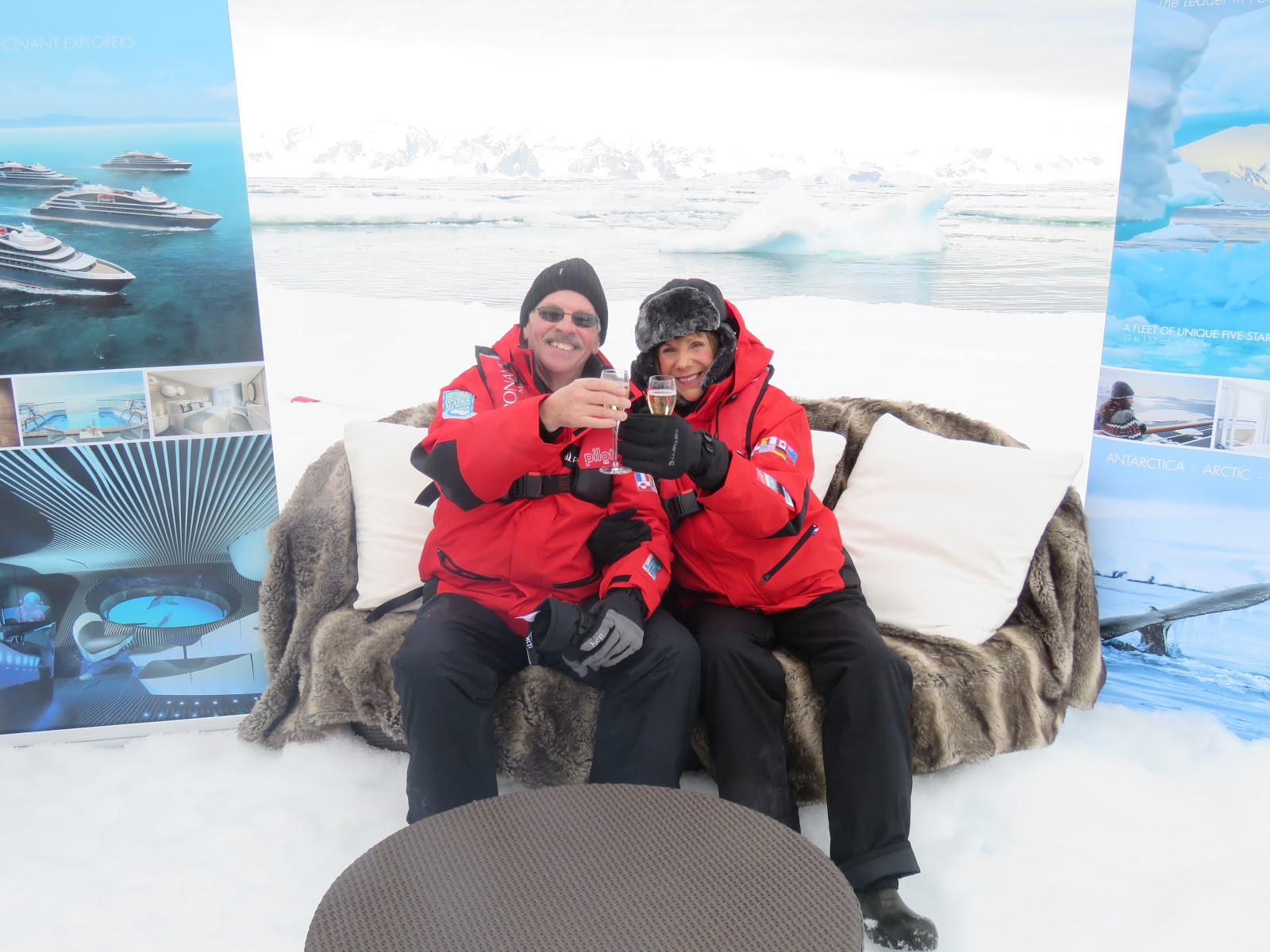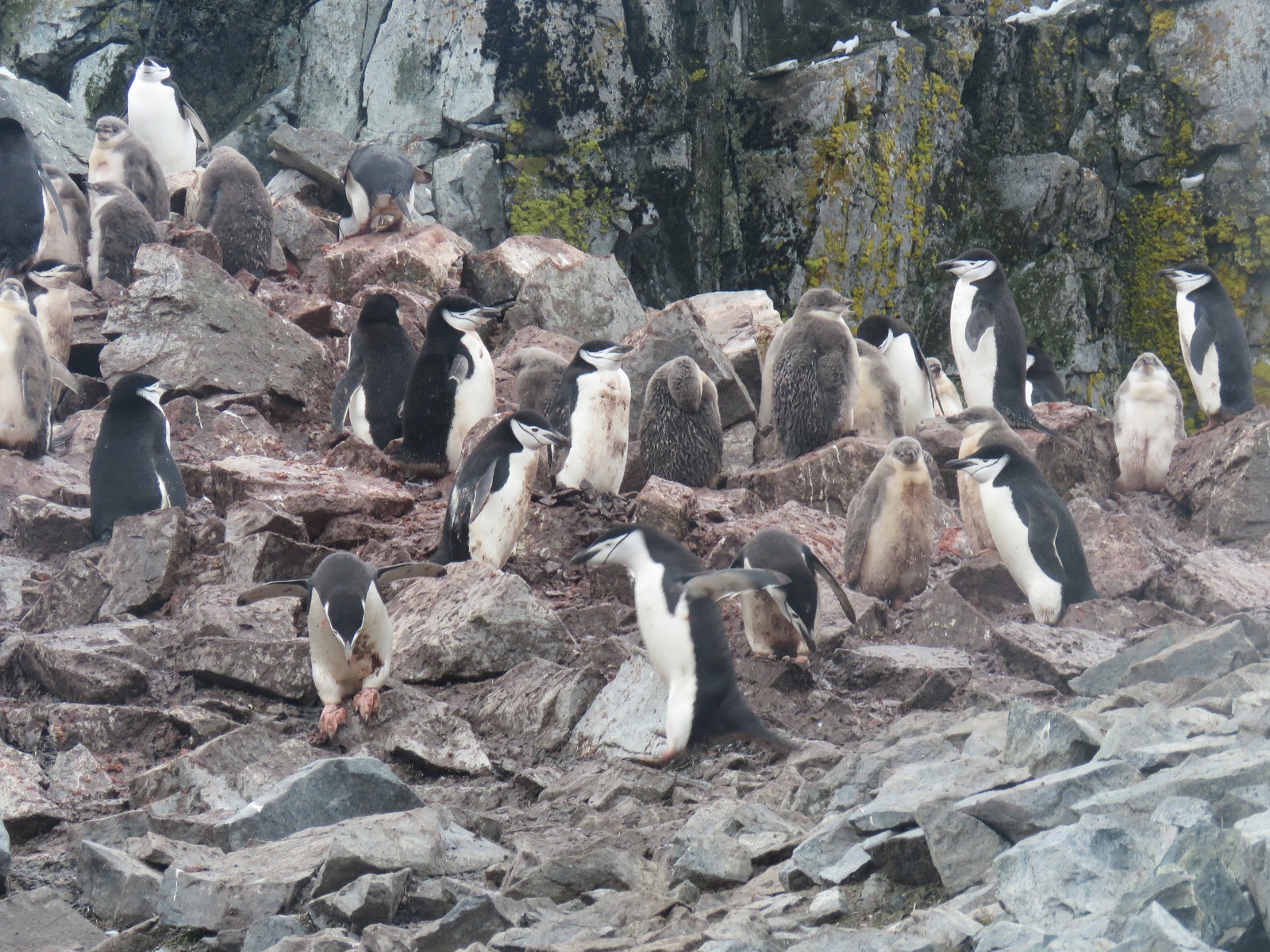 |
| Both of us are raising a glass in celebration of this special occasion. |
The Drake Passage continued to be rough, requiring we hold onto walls and railings when we walk throughout the ship with a degree of added difficulty while maneuvering in the cabin, especially in the bathroom and shower. Last night, the buffet where the 12 of us has dined together on most occasions was closed, and we had no choice but to eat in the main dining room.
 |
| I couldn’t resist lying down for this pose. How fun it was! We loved the sofa and a champagne bar on an ice floe in the Polar Circle. |
Today, it’s settled down, and all dining areas will be open. However, this morning the ship continued to bob, occasionally jerk, and lurch from side to side. We haven’t heard anything from the bridge about the size of the swells or the speed of the winds, both of which we anticipate have been reasonably high.
 |
| Tom with icebergs in the background sitting on the sofa on the ice floe. |
We’ve weathered it well with nary a moment of seasickness for which we’re incredibly grateful. Many passengers had no choice but to wear the seasickness patches or take medication to avert the uncomfortable sensations attributed to getting sick at sea. But surprisingly, many passengers had no ill effects like us.
 |
| The wine steward, Laurent, served us French champagne. |
Later today, we’ll arrive in Ushuaia, where the ship will spend the night. This afternoon, we’ll pack, leaving out enough clothing to get us through the next 24 hours. We’re baffled as to why the ship designated tonight as a “dress up” night when everyone needs to have their baggage ready for pickup around 10:00 or 11:00 pm. As a result, we’ll be casual tonight as usual.
 |
| It was fun to hold up our US flag on the ice floe. |
Now, as the cruise winds down, I’m feeling a little sad to see it end. Without a doubt, this ranks in my top three experiences since we began traveling the world in October 2012. It’s an expensive once-in-a-lifetime adventure leaving us with photos, stories, and videos we’ll always regard as treasured memories.
 |
| The bar was set up on the ice floe earlier in the day, so everything was set and ready to go by the time we arrived. |
We’re thrilled to be heading to Africa next since many other locations could be anticlimactic after this incredible experience. Africa won’t disappoint, and I expect we’ll handle the transition with ease, even with the vast difference in weather conditions. It will be hot for a while longer in South Africa during their hot and humid summer months.
 |
| Tom was holding the “I crossed the Polar Circle” sign while sitting on the sofa. |
Fortunately, we’ll have air conditioning in the bedroom, and we’ll spend most of our days outdoors on the veranda. As excited as we’ve been during this outstanding cruise, a slight tinge of excitement impacted me, knowing on February 11th, we’ll arrive in Mpumalanga, Nelspruit/Kruger, albeit very tired after the long flight with layovers, to commence the 90-minute drive to Marloth Park.
 |
| Both of us are holding the “I crossed the Polar Circle” sign. |
We still have many Antarctic photos and videos we’ve yet to share. We will attempt to wrap them up while in Buenos Aires during our final two days in Palermo Soho while we reorganize our packing, get laundry done (we only hand-washed underwear on the cruise) and get ready upcoming long flight.
 |
| The sun was setting on the icy waters. |
Tonight, we booked a table for 10 in the buffet for our final meal with our group of new friends. We all prefer to dine in the buffet where the options are many and the food more appealing for all of us than in the main dining room with limited menu options.
 |
| There is exquisite scenery at every turn. |
Overall, Tom hasn’t been thrilled with the food (picky eater), but I found it suitable for my diet and don’t complain. As for food photos, I’ve yet to show many when food was the last thing on my mind during this adventure.
 |
| The sun was reflecting on the sea during daylight hours. |
Today, we’re excited to share the photos of one of the most enjoyable events during the cruise, drinking French champagne, once again after a Zodiac boat ride, but this time, in the Arctic Circle on an ice floe, not while in the Zodiac as we shared a few days ago. This theatrical event left all of us reeling with sheer delight over the irony of the situation.
 |
| It was fascinating to see how the ship and Zodiac boats maneuvered through the ice-filled waters. |
Who stands on an ice floe, sipping champagne? What an exquisite touch added to this magnificent cruise! We’re all still talking about it, along with all the other exceptional experiences we’ve had during this past almost 17 days and 16 nights.
 |
| Icebergs often develop into artistic designs. |
Since we’ll be getting off the ship before 8 am tomorrow, this afternoon, we hope to have time to prepare tomorrow’s post with the “final expenses” to upload around our usual earlier time of the day automatically. We’ll be adding “favorite photos” in the two or three posts we’ll prepare in Buenos Aires.
 |
| A single Crabcatcher Seal on an ice floe. |
If, for some reason, we can’t get tomorrow’s post done today, we’ll finish it once we arrive in Palermo later in the day. In other words, there will be a post tomorrow, but at this point, the exact time is up for grabs.
 |
| It has been exciting to see wildlife sunning on ice floes. |
 |
| Another Crabcathcer Seal was lounging on an ice floe. |
Stay well. Stay happy and please, stay tuned for more.
 |
| A white sand beach in Dover, Tasmania. For more photos, please click here. |
























































































